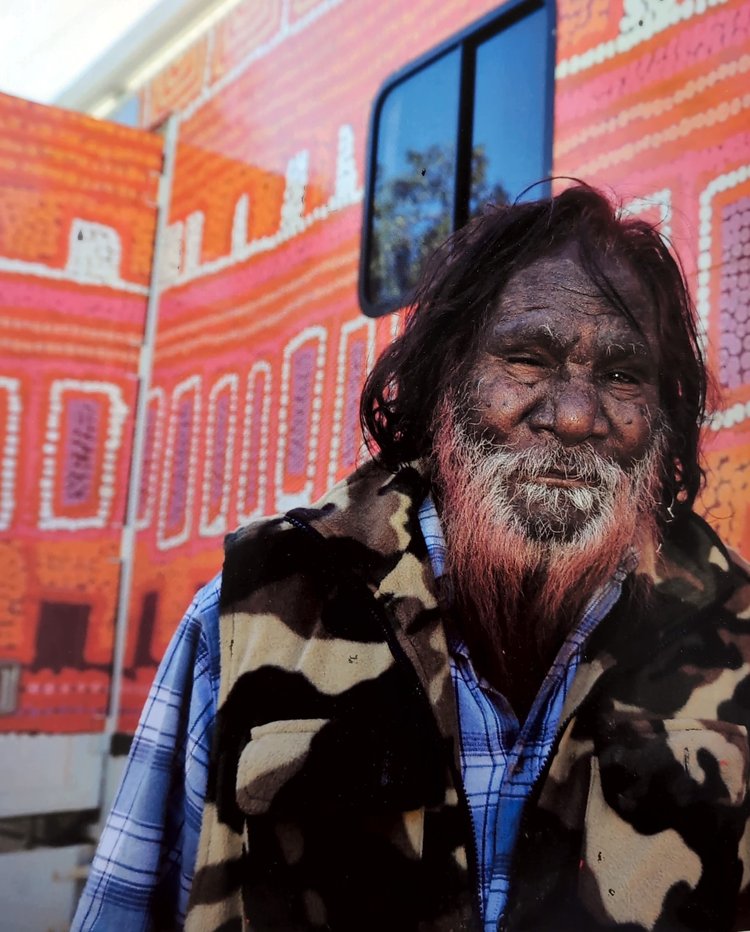PATRICK OLOODOODI TJUNGURRAYI
BIOGRAPHY

Patrick Tjungurrayi was born in Yalangerri near Jupiter Well c.1935. A Pintubi and Kukatja speaker, he walked in from the desert while on the Canning Stock route, and moved in to the Old Balgo Mission, which had been established in 1943. Here he worked building the stone houses and, after the community moved in 1962, constructing the church at the new Balgo site. He met and married Mirriam Olodoodi, Lucy Yukenbari's sister, at the church in Balgo but returned to Kintore shortly after while she remained behind. Through the early 1980’s Patrick travelled to Christmas Creek, Docker River and a number of other western desert and coastal Kimberley communities doing a variety of jobs ranging from construction, labouring and working on boats until he rejoined his wife once more in Balgo Hills.
He created his first paintings when the Palatine brothers first supplied art materials in 1985 and after the establishment of Warlayirti artists two years later Patrick became a regular painter along with his older brother Brandy January Tjungurrayi and younger sister Elizabeth Nyumi Nungurayi. While he painted for the Balgo Hills art centre for almost a decade, he and Brandy moved between their Pintupi homeland community of Kiwirrkura and Balgo Hills for important gatherings and ceremonies and, eventually resettled closer to his homeland and painted for Papunya Tula artists. Over time, both Patrick’s and Brandy’s works of art showed the influence of both of these centres of art making.
Due in part to this cultural synthesis, Patrick Tjungurrayi’s work differs from that of other Papunya Tula male artists. His paintings are boldly enlivened by influences from Balgo, exhibiting a strong use of colour and vivid tonal contrasts. They are powerful, intensified by a flickering optical effect, while simultaneously conveying a sense of earthbound, ‘desert warmth’ (Crawford, 2005). Yet while they exhibit Warlayirti artist’s strong attraction to colour, they maintain the tight formal structure of the Pintupi tradition, associated with Papunya Tula art, as well as their preference for combining colours of similar tonal quality.
Patrick is a senior ‘Law Man’ who is custodian for ceremonies and country between Balgo, Kiwirrkura and Kintore. His paintings resonate with his deep ceremonial knowledge and authority as a respected leader amongst his people. The subject matter revolves around the mythical Tingari stories that underlie the creation of the sacred sites throughout his country Kallianku, west of Jupiter Well. This is a site that is associated with the Rain Dreaming where, in mythological times two Tingari men, Tjapaltjarri and Tjampitjinpa, travelled from the north creating storms and lightning, which brought rain and caused the creeks to flow. The site is also associated with the travels of the Wati Kutjarra, the two initiated brothers who spent time here where water was plentiful during the creation period. In their sleep they would roll around on the ground while dreaming and leave paths marked in earth that became creeks. His paintings of Warriya, a claypan and lake, west of Kiwirrkura, are also associated with the Tingari creators who travelled eastwards through this site at the same time as two snake ancestors. Being a senior Law Man and custodian he also paints the Rain Dreaming site of Putinjana, another special ‘Law’ ground for men only and well as Wanawarra, the Rainbow Serpent.
Patrick Olodoodi was a successful member of Warlayirti artists while he lived and worked in Balgo Hills. However he was not regarded as an artist of major importance while he lived there. His canvases tended to be small, rarely larger than 120 x 80 cm., and these were never put aside for exhibitions in which his work would be distinguishable from that of any of a number of other more prolific artists. He moved back to Kiwirrkurra, closer to his country around 1995 and, after traveling between the two communities for several years, eventually settled at Kiwirrkura toward the end of the 1990’s, painting for Papunya Tula artists since that time. His success as an artist has been consolidated since 2000 with his inclusion in the landmark exhibition Papunya Tula Genesis and Genius at the Art Gallery of New South Wales and a number of other key exhibitions including his entry in the Telstra National Aboriginal and Torres Strait Art Award for the first time in 2004. He has worked on larger canvases since then and his major works have appeared in important Papunya Tula Artist exhibitions at Gallery Gabrielle Pizzi and Scott Livesey Gallery in Melbourne, A.P.Bond in Adelaide, Utopia Art in Sydney and John Gordon Gallery in Coffs Harbour. With many of the important Papunya men painting for independent dealers outside of the company in recent years, Patrick Tjunurrayi’s paintings with Papunya Tula provenance have become highly sought after, and will remain be so, as long as he continues to paint significant works of quality.
© Adrian Newstead
References
Crawford, A., Art Collector, #31, 2005, p.104
Johnson, Vivien, Lives of the Papunya Tula Artists, IAD Press, 2008
Perkins, H., and Fink, H., Papunya Tula, Genesis and Genius, Art Gallery of New South Wales, Sydney, 2000

